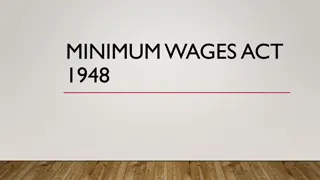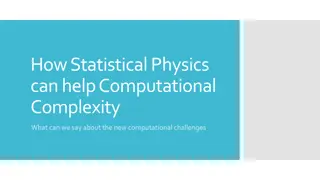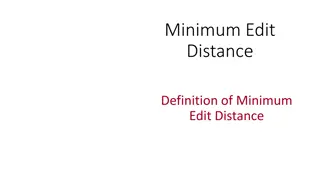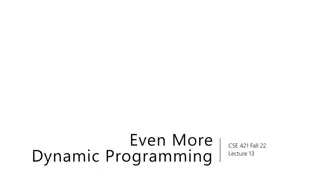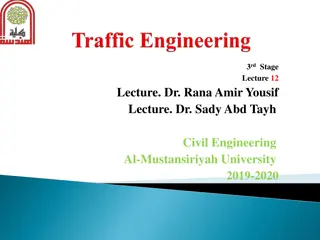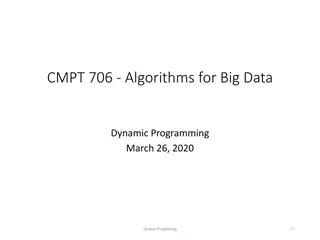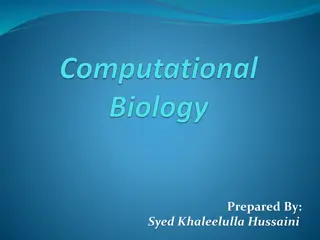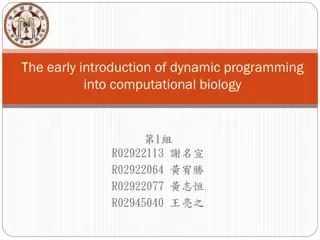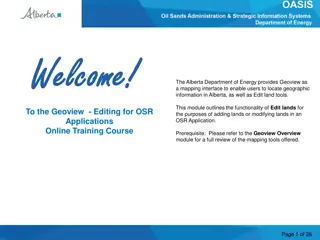Understanding Minimum Edit Distance in Computational Biology
Dan Jurafsky explains the concept of minimum edit distance as the minimum number of editing operations such as insertion, deletion, and substitution needed to transform one string into another. Through examples and visual representations, he illustrates how minimum edit distance plays a crucial role in tasks like spell correction, aligning nucleotide sequences, machine translation, information extraction, and speech recognition in computational biology and natural language processing.
Download Presentation

Please find below an Image/Link to download the presentation.
The content on the website is provided AS IS for your information and personal use only. It may not be sold, licensed, or shared on other websites without obtaining consent from the author. Download presentation by click this link. If you encounter any issues during the download, it is possible that the publisher has removed the file from their server.
E N D
Presentation Transcript
Minimum Edit Distance Definition of Minimum Edit Distance
Dan Jurafsky How similar are two strings? Spell correction The user typed graffe Which is closest? graf graft grail giraffe Computational Biology Align two sequences of nucleotides AGGCTATCACCTGACCTCCAGGCCGATGCCC TAGCTATCACGACCGCGGTCGATTTGCCCGAC Resulting alignment: -AGGCTATCACCTGACCTCCAGGCCGA--TGCCC--- TAG-CTATCAC--GACCGC--GGTCGATTTGCCCGAC Also for Machine Translation, Information Extraction, Speech Recognition
Dan Jurafsky Edit Distance The minimum edit distance between two strings Is the minimum number of editing operations Insertion Deletion Substitution Needed to transform one into the other
Dan Jurafsky Minimum Edit Distance Two strings and their alignment:
Dan Jurafsky Minimum Edit Distance If each operation has cost of 1 Distance between these is 5 If substitutions cost 2 (Levenshtein) Distance between them is 8
Dan Jurafsky Alignment in Computational Biology Given a sequence of bases AGGCTATCACCTGACCTCCAGGCCGATGCCC TAGCTATCACGACCGCGGTCGATTTGCCCGAC An alignment: -AGGCTATCACCTGACCTCCAGGCCGA--TGCCC--- TAG-CTATCAC--GACCGC--GGTCGATTTGCCCGAC Given two sequences, align each letter to a letter or gap
Dan Jurafsky Other uses of Edit Distance in NLP Evaluating Machine Translation and speech recognition R Spokesman confirms senior government adviser was shot H Spokesman said the senior adviser was shot dead S I D I Named Entity Extraction and Entity Coreference IBM Inc. announced today IBM profits Stanford President John Hennessy announced yesterday for Stanford University President John Hennessy
Dan Jurafsky How to find the Min Edit Distance? Searching for a path (sequence of edits) from the start string to the final string: Initial state: the word we re transforming Operators: insert, delete, substitute Goal state: the word we re trying to get to Path cost: what we want to minimize: the number of edits 8
Dan Jurafsky Minimum Edit as Search But the space of all edit sequences is huge! We can t afford to navigate na vely Lots of distinct paths wind up at the same state. We don t have to keep track of all of them Just the shortest path to each of those revisted states. 9
Dan Jurafsky Defining Min Edit Distance For two strings X of length n Y of length m We define D(i,j) the edit distance between X[1..i] and Y[1..j] i.e., the first i characters of X and the first j characters of Y The edit distance between X and Y is thus D(n,m)
Minimum Edit Distance Definition of Minimum Edit Distance
Minimum Edit Distance Computing Minimum Edit Distance
Dan Jurafsky Dynamic Programming for Minimum Edit Distance Dynamic programming: A tabular computation of D(n,m) Solving problems by combining solutions to subproblems. Bottom-up We compute D(i,j) for small i,j And compute larger D(i,j) based on previously computed smaller values i.e., compute D(i,j) for all i (0 < i < n) and j (0 < j < m)
Dan Jurafsky Defining Min Edit Distance (Levenshtein) Initialization D(i,0) = i D(0,j) = j Recurrence Relation: For each i = 1 M For each j = 1 N D(i-1,j) + 1 D(i,j)= min D(i,j-1) + 1 D(i-1,j-1) + 2; if X(i) Y(j) 0; if X(i) = Y(j) Termination: D(N,M) is distance
Dan Jurafsky The Edit Distance Table N O I 9 8 7 T N E T N I # 6 5 4 3 2 1 0 # 1 E 2 X 3 E 4 C 5 U 6 T 7 I 8 O 9 N
Dan Jurafsky The Edit Distance Table N O I 9 8 7 T N E T N I # 6 5 4 3 2 1 0 # 1 E 2 X 3 E 4 C 5 U 6 T 7 I 8 O 9 N
Dan Jurafsky Edit Distance N O I 9 8 7 T N E T N I # 6 5 4 3 2 1 0 # 1 E 2 X 3 E 4 C 5 U 6 T 7 I 8 O 9 N
Dan Jurafsky The Edit Distance Table N O I T N E T N I # 9 8 7 6 5 4 3 2 1 0 # 8 7 6 5 4 3 4 3 2 1 E 9 8 7 6 5 4 5 4 3 2 X 10 9 8 7 6 5 6 5 4 3 E 11 10 9 8 7 6 7 6 5 4 C 12 11 10 9 8 7 8 7 6 5 U 11 10 9 8 9 8 7 8 7 6 T 10 9 8 9 10 9 8 7 6 7 I 9 8 9 10 11 10 9 8 7 8 O 8 9 10 11 10 9 8 7 8 9 N
Minimum Edit Distance Computing Minimum Edit Distance
Minimum Edit Distance Backtrace for Computing Alignments
Dan Jurafsky Computing alignments Edit distance isn t sufficient We often need to align each character of the two strings to each other We do this by keeping a backtrace Every time we enter a cell, remember where we came from When we reach the end, Trace back the path from the upper right corner to read off the alignment
Dan Jurafsky Edit Distance N O I 9 8 7 T N E T N I # 6 5 4 3 2 1 0 # 1 E 2 X 3 E 4 C 5 U 6 T 7 I 8 O 9 N
Dan Jurafsky MinEdit with Backtrace
Dan Jurafsky Adding Backtrace to Minimum Edit Distance Base conditions: Termination: D(i,0) = i D(0,j) = j D(N,M) is distance Recurrence Relation: For each i = 1 M For each j = 1 N D(i-1,j) + 1 D(i,j)= min D(i,j-1) + 1 D(i-1,j-1) + 2; if X(i) Y(j) 0; if X(i) = Y(j) LEFT ptr(i,j)= DOWN DIAG substitution deletion insertion substitution insertion deletion
Dan Jurafsky The Distance Matrix x0 xN Every non-decreasing path from (0,0) to (M, N) corresponds to an alignment of the two sequences An optimal alignment is composed of optimal subalignments y0 yM Slide adapted from Serafim Batzoglou
Dan Jurafsky Result of Backtrace Two strings and their alignment:
Dan Jurafsky Performance Time: Space: Backtrace O(nm) O(nm) O(n+m)
Minimum Edit Distance Backtrace for Computing Alignments
Minimum Edit Distance Weighted Minimum Edit Distance
Dan Jurafsky Weighted Edit Distance Why would we add weights to the computation? Spell Correction: some letters are more likely to be mistyped than others Biology: certain kinds of deletions or insertions are more likely than others
Dan Jurafsky Confusion matrix for spelling errors
Dan Jurafsky Weighted Min Edit Distance Initialization: D(0,0) = 0 D(i,0) = D(i-1,0) + del[x(i)]; 1 < i N D(0,j) = D(0,j-1) + ins[y(j)]; 1 < j M Recurrence Relation: D(i-1,j) + del[x(i)] D(i,j)= min D(i,j-1) + ins[y(j)] D(i-1,j-1) + sub[x(i),y(j)] Termination: D(N,M) is distance
Dan Jurafsky Where did the name, dynamic programming, come from? The 1950s were not good years for mathematical research. [the] Secretary of Defense had a pathological fear and hatred of the word, research I decided therefore to use the word, programming . I wanted to get across the idea that this was dynamic, this was multistage I thought, let s take a word that has an absolutely precise meaning, namely dynamic it s impossible to use the word, dynamic, in a pejorative sense. Try thinking of some combination that will possibly give it a pejorative meaning. It s impossible. Thus, I thought dynamic programming was a good name. It was something not even a Congressman could object to. Richard Bellman, Eye of the Hurricane: an autobiography 1984.
Minimum Edit Distance Weighted Minimum Edit Distance







